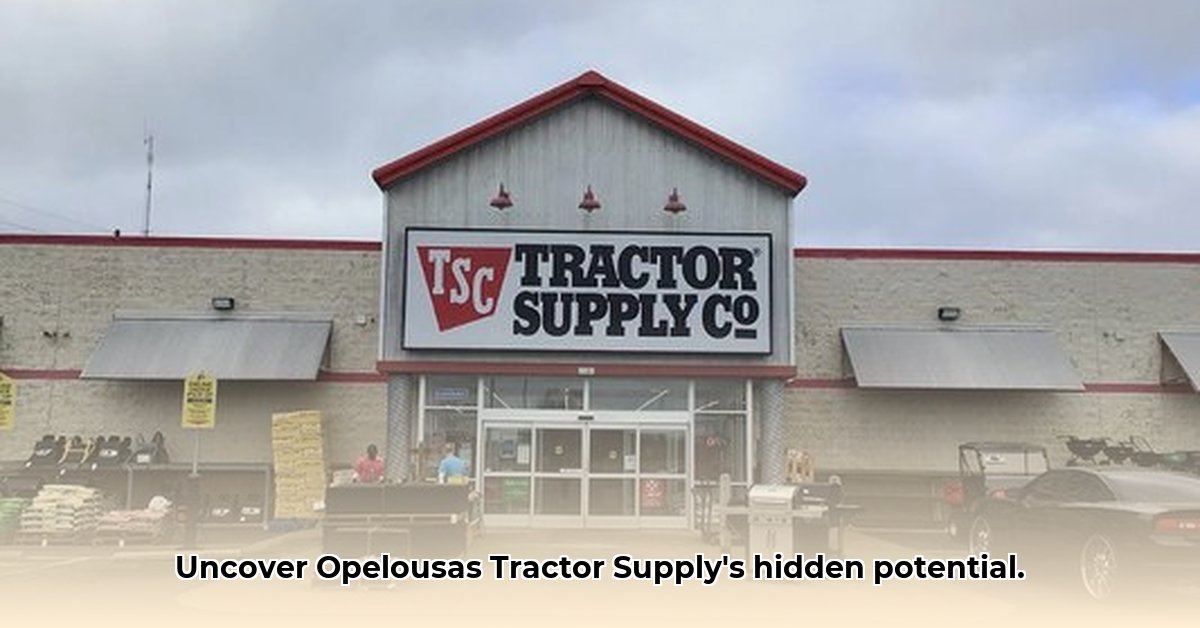
This report analyzes the performance of the Tractor Supply Company (TSC) store in Opelousas, Louisiana, identifying key strengths, weaknesses, opportunities, and threats (SWOT) to inform strategic improvements. The analysis focuses on market position, competitive landscape, and operational efficiency, offering actionable recommendations for enhanced profitability and sustainable growth.
Market Assessment and Competitive Landscape
The Opelousas TSC store, located at 241 Acadiana Prep Circle, benefits from a strategic position along US Route 190, providing convenient access for customers in Opelousas and surrounding communities like Port Barre and Grand Coteau. Its extended operating hours (8 am to 9 pm) aim to maximize customer convenience. However, a comprehensive evaluation requires detailed sales data currently unavailable, hindering a precise assessment of market share and competitive advantage.
A thorough market analysis is crucial to understanding the competitive landscape. Identifying primary competitors (e.g., other farm supply stores, hardware stores offering similar products) and their market penetration will inform strategies for differentiation. This analysis must also account for the unique agricultural practices and demands of the local farming communities. For example, are there high demands for specific crops or livestock that dictate unique product needs? Understanding local agricultural trends and their impact on product demand is essential for effective inventory management.
Operational Efficiency and Supply Chain Assessment
The current lack of detailed sales data prevents a thorough evaluation of operational efficiency. Analyzing sales figures, inventory turnover rates, and staffing levels is crucial for optimizing resource allocation and minimizing waste. This granular analysis is vital and will highlight areas for improvement in inventory management and staffing. How do current staffing levels align with peak and off-peak demands? A data-driven approach to optimize these factors will ensure the appropriate level of employee support for peak demand, maintaining customer service while minimizing unnecessary labor costs.
Further investigation into the supply chain is needed. Analyzing supplier relationships, transportation efficiency, and inventory management processes will identify potential areas for cost reduction and improved reliability. Understanding how current supply chain difficulties—such as recent inflationary pressures and shortages—affect profitability and product availability is critical for mitigating future challenges. Are there opportunities to diversify suppliers or streamline logistics to enhance resilience and responsiveness to supply chain disruptions?
Actionable Steps for Enhanced Performance
To enhance the Opelousas TSC store's performance, a multi-phased approach is recommended.
Phase 1: Data Acquisition and Market Research (0-3 Months)
- Comprehensive Sales Data Analysis: Obtain detailed sales data to assess product performance, identify top-selling items, and pinpoint areas for improvement. (Efficacy Metric: Reduction in inventory holding costs by 15% within 6 months).
- Competitor Analysis: Conduct a thorough analysis of competing farm supply businesses within a 50-mile radius to gauge market share, pricing strategies, and product offerings. (Efficacy Metric: Identification of 3 key differentiators within 3 months).
- Customer Segment Profiling: Conduct customer surveys and interviews to better understand customer needs, purchasing habits, and preferences. (Efficacy Metric: Improvement in customer satisfaction scores by 10% within 6 months).
Phase 2: Operational Optimization and Marketing (3-12 Months)
- Inventory Management and Optimization: Implement a data-driven inventory management system to optimize stock levels, reduce waste, and ensure timely replenishment of high-demand items. (Efficacy Metric: Inventory turnover rate improvement by 20% within 12 months).
- Enhanced Customer Engagement: Implement strategies to improve customer service, enhance in-store experience, develop customer loyalty programs, and build stronger relationships with the local farming community. (Efficacy Metric: Increase in customer retention rate by 10% within 12 months).
- Website Enhancement: Upgrade the store's online presence to improve navigation, information accessibility, and online ordering capabilities. (Efficacy Metric: 20% increase in website traffic and 15% increase in online sales within 12 months).
Phase 3: Strategic Growth and Expansion (12-36 Months)
- Sustainability Initiatives: Explore opportunities to offer a wider range of sustainable agricultural products, aligning with growing consumer demand for eco-friendly solutions. (Efficacy Metric: 10% sales growth from sustainable products within 24 months).
- Product Line Diversification: Analyze local market needs and expand product offerings to encompass unmet demands. (Efficacy Metric: 5% increase in average transaction value within 18 months).
- Potential Expansion: Evaluate the feasibility of expanding to additional locations within the region based upon market demand and profitability analysis. (Efficacy Metric: Completion of feasibility study and expansion proposal within 24 months).
Risk Assessment and Mitigation
Several factors could negatively impact the Opelousas TSC store's performance.
- Intense Competition: The presence of other farm supply retailers necessitates a clear differentiation strategy to maintain market share. Mitigation: Focus on specialized products or exceptional customer service.
- Supply Chain Disruptions: Global and local supply chain challenges can affect product availability and pricing. Mitigation: Diversify suppliers and build strong relationships with key partners.
- Economic Downturns: Economic slowdowns can reduce consumer spending and impact demand for non-essential goods. Mitigation: Implement cost-control measures and focus on efficiency.
- Changing Consumer Preferences: Shifting consumer preferences toward sustainable agriculture practices present both a challenge and opportunity. Mitigation: Closely monitor these trends and adapt product offerings accordingly.
Regulatory Compliance
Strict adherence to all applicable local, state, and federal regulations is paramount. This includes zoning laws, environmental protection regulations, and labor laws. Proactive compliance minimizes legal and financial risks, fostering long-term stability.
Conclusion
The Opelousas TSC store holds substantial potential for growth. However, realizing this potential requires a data-driven approach, focused on understanding the local market, optimizing operations, and proactively managing risks. By implementing the recommendations outlined in this report, the store can significantly enhance its performance, build stronger community relationships, and achieve sustainable profitability.